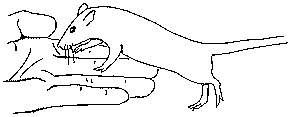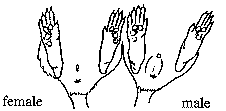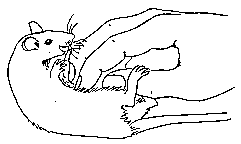The Rat Fan Club

Rats! The Perfect Pet?
Let's hear it for rats! These friendly, curious, affectionate animals are unfortunately ignored or even despised by many people. Say the word “rat” and most people think of wild rats, but domestic rats are as different from wild rats as dogs are from wolves! Some of us rat fans like to call our rattie companions ratzels, ratzies or raffins.
Rats are great companions for both adults and kind, responsible kids. Because rats are so small, children under age 8 should interact with rats under adult supervision to insure proper handling.
Rats are especially suited as companions because they’re social animals (unlike hamsters) and love to interact with people. They're very personable and bond to people. Most rats will beg to be petted or to come out and play, and many will show affection by grooming their people with licks and gentle nibbles. Many rats like to sit on a shoulder just to be with their person.
Rats are smart enough to learn their name and to come when called. They love to play games with people, from wrestling and chase, to hide-n-seek, tag, and peek-a-boo! They can even learn to sit up, jump through a hoop, play basketball and do many other tricks.
Rats have very little odor and they keep themselves clean with constant grooming. Any bad odor is caused by wastes and means the cage isn’t being cleaned often enough for the type of litter being used. Rats need less maintenance (and general care is less expensive) than larger companion animals such as dogs, but they do need regular care, and do best with plenty of attention and playtime. Naturally nocturnal, rats are most active in the morning and evening when most people are home from work or school. But they will easily adjust their schedule to come out for attention during the day. And unlike some other companion animals, rats are very quiet.
The Cloud in the Silver Lining
Rats do have a few bad points. Being rodents, they can have a tendency to chew on things, although this is an individual trait, and some rats chew very little. But any rat can quickly produce holes in clothing, furnishings, and electrical wires. Punishment will not eliminate this behavior, which is instinctive. It’s recommended that rats out of their cage be supervised, and any area where they’re allowed to play “rat-proofed” to remove any dangerous or valuable items.
Another annoyance is their habit of urine marking. They will often leave tiny drops of urine where they walk to mark their territory. Males urine mark more than females, but fortunately neutering almost always eliminates this behavior in males. The spots of urine are easily wiped up from hard surfaces but they can stain fabrics. A washable throw cover can protect furniture, but if rats are allowed to run on carpets, periodic carpet cleaning may be necessary.
For most people, the main drawback of rats is their short lifespan, which currently averages 2 to 3 years. An incurable respiratory disease is extremely common in rats, females are very prone to tumors (although spaying reduces the incidence), and it can be difficult to find vets experienced in treating rats. However, with proper care—especially proper diet—rats have the potential to live to 4 or 5. The Guiness Book of World Records lists the record rat lifespan at 7 years 4 months! And even though rats may have a short life, in the time they do have with us they give so much love and enjoyment!
Choosing a Rat
While rats come in a variety of colors and types, the most important characteristics to look for are personality and good health. All rats have their own personality and while most are outgoing and friendly if properly socialized before weaning, some can be shy, nervous, or independent. Rats who aren’t afraid to nibble on your fingers or climb on your hand make the best companions. It’s best to choose a rat 4-6 weeks old, but if your choice is limited to a shy baby, or an adolescent who begs to sit on your shoulder, choose the older rat. Any rat this sociable will make an excellent companion. You might even let a rat choose you!
Males are larger than females when grown, and tend to be less active and therefore better lap pets. Females are less fond of holding still, are less likely to urine mark, and are more prone to getting tumors (although these can be prevented by spaying). Both sexes make affectionate pets.
Whatever sex you choose, it’s best to get at least two. Rats are very social and get lonely by themselves. As long as you spend time with each one, they will bond to you as well as to each other. If you get just one rat you must spend a lot of time playing with him. Be sure roommates are the same sex, or have one or both neutered. A breeding pair can produce a litter of 12 babies every 4 weeks! And here’s a warning: females over 5 weeks of age can already be pregnant if they’ve been with any males!

Sexing rats is fairly easy with a few guidelines. First, check the rat yourself—pet shop employees can make mistakes. By the time the baby rats are weaned (4 weeks of age) the males’ testicles will have dropped, but they aren’t always obvious because they can be voluntarily pulled inside the body. The most definite test is to press down gently on either side of what appears to be a penis—the urinary opening for a female looks a lot like a penis—in a male the red penis will pop out, but not in a female. The female also has a vaginal opening directly behind the urinary protuberance.
Choosing A Healthy Rat
Before choosing a rat, spend some time observing the group to see if you can hear any of the rats sneezing or wheezing. These days almost all rats are infected with an incurable respiratory infection caused by a mycoplasma bacteria. Some rats are resistant to the disease, and these are the rats you want to look for. You should avoid any rats with symptoms. Repeated sneezes are the first sign of this disease, followed by wheezing. Any noise a rat makes while breathing, such as wheezing, clicking, “purring,” or grunting is a symptom of a more advanced case. (However, these noises shouldn’t be confused with the chattering noise rats make when they grind their teeth.) Other signs of disease include listlessness, a hunched posture, dull coat, runny eyes or nose, abnormal lumps, or low body weight. A healthy rat—even a baby—should feel firm and hefty for his size and be curious and active. Choosing a healthy friendly rat is the best way to insure a long happy relationship!

Playtime: Rat Wrestling
Before your rat will play with you, you have to gain his trust. At first, when you take him out of his cage, he’ll feel insecure and not much like playing. So, start by playing with your rat inside his cage where he feels secure.
Rats play together by wrestling and chewing on each other just like puppies. If you pretend your hand is another rat, your rat can wrestle with you too. When he’s feeling really playful, he might flip over on his back so you can tickle his belly!
Put your hand in the cage and let your rat sniff and nibble on your fingers. When he seems unafraid, you can wiggle your fingers and stroke him. If that doesn’t scare him, you can gently poke and pinch him to encourage him to get feisty. Sound effects like “ha, ha, ha", "gotcha, gotcha” in a silly voice also seems to get rats excited. Rats actually laugh using ultrasounds when they play!
Rarely, a rat will get too excited and bite a little too hard. If this happens, squeak loudly like a rat would and pull your hand away. Soon your rat will learn not to play so rough.
When your rat feels comfortable outside his cage you can try wrestling with him in other places. Happy playtime!
Do Pet
Rats Bite?
Like dogs, most pet rats do not bite. However, there are two main reasons rats might bite:
1. Rats will defend themselves and their territory (cage), especially if their rat family includes babies. Some will bite strangers if they poke their fingers into the cage or in front of the rat’s face. Rats may also bite when scared, startled, or hurt.
2. Rats will sometimes grab your finger instead of a piece of food or something else they really want, or grab too hard if they smell food on your fingers. Or, if you feed your rat through the bars of his cage, he may get into the habit of grabbing anything that's poked in—even fingers.
To prevent getting bitten by rats, here are some rules:
1. Wash food smell off your hands before playing with rats.
2. Instruct visitors and children not to stick their fingers through the bars of the cage. And always take your rat out of his cage before letting strangers pet him.
3. Never tease your rat, especially with food.
4. Give your rat a signal when you give him a treat, like saying the word “treat” or making a clicking sound, so he won’t get in the habit of grabbing your fingers when you don’t have a treat for him.
5. Use care when there are babies in the cage. Other rats besides the mother may be protective of babies.
6. Don’t startle your rat by grabbing at him too quickly. Talk to him first, wake him up, and make sure he knows you’re going to pick him up.
7. Be very cautious when handling a rat that’s hurt or scared. You may even want to wrap him in a towel before picking him up.
8. Be cautious with new rats, especially older rats. Until they get to know you, they may not trust you and might bite if you reach for them inside their cage. Try inviting them to come out first.
9. Handle your rat frequently—every day is best. A rat that isn’t handled for a while may become distrustful or neurotic and start biting.
Happy and Healthy: What Rats Need
A rat’s basic needs are simple: a safe cage, litter and bedding free of toxins, a bed or house, water bottle, and food dish, fresh foods, and companionship.
Cage—A rat cage should be at least 12" by 24" but buy the largest cage you can. You can choose from wire cages or aquariums, or a combination of the two, stacked or joined with tubes. Most rats enjoy an exercise wheel, but hamster wheels are too small. We recommend the Wodent Wheel which you can order from www.theratshop.com. For more information about cages click here.
A wire cage provides much better ventilation than an aquarium. A pan at least 2" high will help prevent litter from being kicked out. Or guards cut from Plexiglas or acrylic can be placed around the cage. Cages with a solid bottom instead of wire are safer for ratty feet. WARNING: Cages made of 1" by ½" mesh are dangerous because rats can get a back foot stuck in the mesh resulting in a wrenched or broken leg. Because rats climb, the sides as well as elevated floors and ramps are dangerous. For adult rats, cages can be made of 1" square mesh. For babies, cages should be made of ½" square mesh or bars ½" or less apart. Elevated floors should be solid or ½" square mesh or bars less than ½" apart. You can cover unsafe floors with plastic needlepoint canvas which has drainage holes and is easily removed for cleaning. If you choose an aquarium, be sure is has a mesh top for good ventilation. Dirty litter can be removed with a small dust pan and broom or a wet/dry vacuum.
Litter & Bedding—DO NOT use cedar and pine shavings which contain toxins which damage the respiratory tract and liver. Safe alternatives which are excellent at controlling odor include CatWorks, Country Fresh Cat Litter, Critter Country (pellets made from grain by-products), CareFRESH, EZ-FLUSH, Kozy Korner Ferret Litter, Yesterday’s News, Good Mews (paper fibers), Gentle Touch (aspen bark). You can also use aspen shavings, alfalfa pellets or rabbit food! Do not use clay cat litters. Bedding can be shredded paper, felt, or cornhusk or sisal bedding. Use newspaper or other printed paper inside the cage with caution as some ink is toxic. Don’t use cotton, yarn or rags for babies because threads can get wrapped around their legs or necks. For more info on litter and bedding, click here.
Bed—Rats like a snug place to sleep. A variety of clean household items, such as milk jugs, cans, jars and ink-free boxes, are easily replaced when needed. They also love hammocks!
Water bottle—Keeps the water cleaner than a dish. Hard plastic wide-mouth bottles are best. You can make or buy holders to hang the bottle inside aquariums. Never give rats fluoridated water, and bottled is better than chlorinated water.
Food dish—Should be non-tippable. Lixit brand FoodHoppers are great for rat blocks.
Food—Generic grain mix is not adequate for rats! The basic diet should be rat blocks or nuggets (preferred) or a packaged fortified food especially for rats. (Avoid mixes containing a lot of alfalfa pellets.) Supplement with fresh foods like fruits, cooked sweet potato and beans, broccoli, kale, bok choy, tomato, live-culture yogurt, and mealworms. Peel or wash or fruits and vegetables well. I’ve also devised a homemade rat diet recipe using all fresh foods. (Click here.)
Companionship—Rats are very social and are happiest in pairs or groups of same sex or neutered rats. A single rat needs lots of daily human attention.
For a list of available back issues of the Rat Report, click here
Rat of the Week | Intro Issue | Join the Club! | Adopt a Rat
Rat Books
| Helpful Info
| Merchandise
| Special Events
Meet the Ratlady
| Links |
Home
Rat Fan Club 857 Lindo Lane Chico, CA 95973 (530) 899-0605 ratlady@ratfanclub.org
Copyright 1999-2007